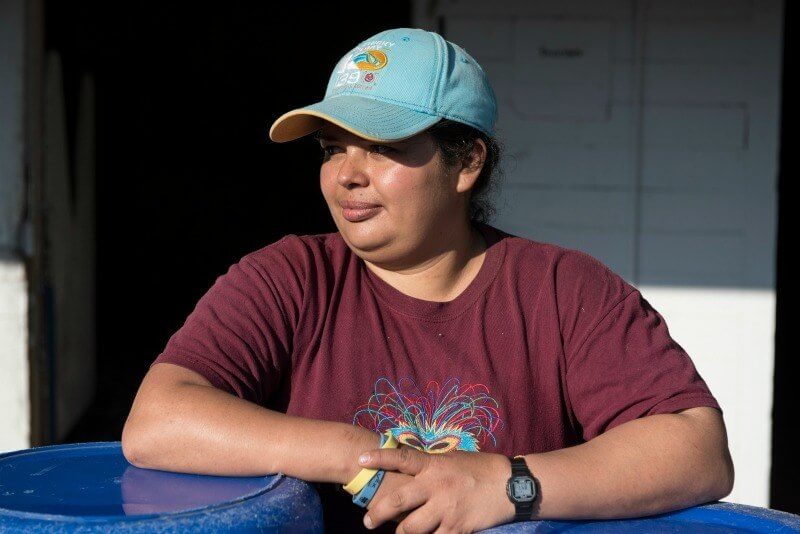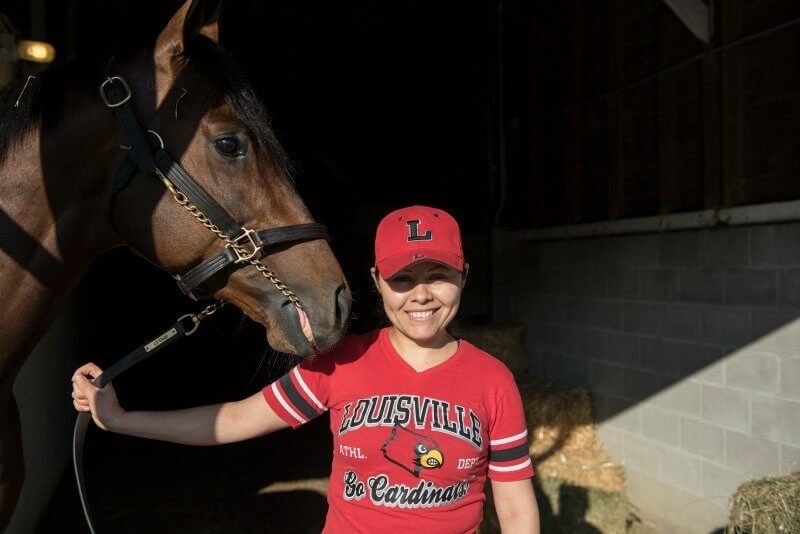The historic Kentucky Derby, Louisville’s most famous event, is well-known around the world. It’s a day filled with excitement, celebrity sightings, glamorous fashion and all those amazing hats. But what is less known about Kentucky’s signature event is all the work that happens behind the scenes to make the greatest two minutes in sports happen, especially on the backside, where highly skilled and dedicated people work hard to care for the main attractions: the horses.
While thousands of people flock to Churchill Downs on the first Saturday in May to experience the thrilling run for the roses, barn staff work diligently behind the scenes to make it all possible. These unsung heroes aren’t part of the visible celebrations or glory, but without their hard work, none of it would be possible.
Anyone who knows anything about the equine industry knows thoroughbred race horses require constant and consistent care and upkeep. That means hours of hands-on work with the horses, sticking to a strict schedule and making sure that all areas of the barn stay productive. To be a worker on the backside is not just a job – it’s a unique, all-encompassing lifestyle. And that’s why the Backside Learning Center was created.

The Backside Learning Center (BLC) was founded in 2004 through a joint partnership between the Klein Family, WinStar Farms and Churchill Downs. Initially created as a lending library and place for English language instruction, the BLC has grown into an integral support hub for all backside workers and their families, especially their children. Workers who participate – BLC “students” – benefit from daily educational programming like English as a Second Language classes, technology workshops and even art and music classes. But just as importantly, the staff and volunteers at the BLC are also equipped to assist BLC students with finding resources that support their daily lives, like an after-school program for the children of backside workers, social services and referrals, and translation and interpretation services. The BLC also serves as a community center and a “home away from home” for the nearly 1,000 workers at Churchill Downs who can find themselves far from family and friends.
To find out more about the people the BLC serves, we asked Director Sherry Stanley to introduce us to a few of their students to find out more about their daily lives as workers on the backside. We met three women – Brenda Salazar, Maria Herrera and Marta Covarrubis – who graciously allowed us to follow them around as they worked. Here are their stories about life on the backside.

Brenda Salazar, Hot Walker
Brenda Salazar has been a hot walker for 11 years. She was introduced to the equine industry through her family and friends while young, and she fell in love with the horses. She begins her day at 5 a.m., and wakes long before the sun comes up. Brenda walks horses for 30 minutes after their morning workouts, then makes sure they are rehydrated and bathed before she returns them to their stalls to relax. She leaves the barn at 10 a.m. and returns at 3 p.m. to tend to the horses after their afternoon workouts, wrapping up her day around 4:30 p.m.

Hot walkers play a vital role in the success of a horse’s career. Racehorses work hard – twice as hard when a big race approaches – so cooling them down properly after a race or tough workout is essential to their health. In the course of one day, Brenda will work with four to five horses.
“I like the connection you can make with the horses,” Brenda explains. “When you have a connection, they react well and are more calm.”
When the horses haven’t formed a connection with you or they aren’t well-behaved, the job of a hot walker can be dangerous. Brenda says this is the most challenging part of her job. It’s rare that a horse won’t bond with someone it sees and works with every day, but working with animals always brings an element of uncertainty.

A highlight for Brenda has been working with a barn that had an Oaks-winning horse.
“It’s a good feeling to be a part of that day,” Brenda says. ” You trained all year long and you know that horse is prepared. It’s a community feeling and a very unique feeling because not every barn can have that experience, and not every horse you work with wins.”
Maria Herrera, Groom
Maria Herrera has worked as a groom at Churchill Downs for 10 years. Waking at 3:45 a.m. to prepare herself and her children for the day, Maria arrives at the track by 4:40 a.m., where she’s responsible for looking after and taking care of the daily routines of five horses. She takes temperatures, cleans and waters stalls, prepares each horse for the track and bathes them post-workout. Like Brenda, Maria ends her morning duties at around 10 a.m., leaves the barn until 3 p.m., when she returns to clean the stalls and take temperatures again before wrapping up her day at 4:20 p.m.

Working in the equine industry was a natural fit for Maria. Her father owned horses in Guatemala, where she grew up, and Maria learned how to handle and care for horses early.
“The hardest part of my job is balancing five horses,” Maria tells us. “They come off and go onto the track quickly, so I have to work quickly, but effectively.”
On race days, the horses move at an even faster pace and the workers must follow suit, especially on Derby day. On the first Saturday in May, the backside at Churchill Downs opens later and closes sooner, which gives the workers a shorter window of time to perform their tasks and make sure the needs of the horses are properly met.
“It’s hectic on Derby day,” Maria says. “There’s a feeling of excitement, but also pressure. There are a lot more people and children on the backside, which can scare the horses.”
It’s not all work and no play for the backside workers on Derby day. Maria and the other backside workers finish early by 9:30 a.m., giving them plenty of time to go home, change clothes and return to the barns to enjoy the celebratory atmosphere.
“It’s always crowded,” Maria explains with a smile. “We watch the races on the televisions and have a potluck cookout with other workers.”
Marta Covarrubis, Foreman
Marta Covarrubis started her career as a groom and was promoted to foreman three years ago. She is on the move by 5 a.m., implementing day-to-day horse life routines and carrying out the trainer’s plan of action. Marta is essentially responsible for keeping the horses healthy and happy. She manages barn staff, enforces feeding and cleaning schedules, maintains equipment, applies medications and enforces exercise routines. Like the rest of the backside workers, she breaks for the afternoon at 11 a.m. When she returns to the track, she takes temperatures, makes sure horses are on schedule and lets her boss know when work is complete.
“My favorite part of the job is the horses … when they’re sweethearts,” Marta beams. “I hate when they don’t behave.”

The Impact of the Backside Learning Center
The backside is more than just a place of employment for these three women. When asked about their favorite aspect of the Backside Learning Center, Marta is quick to respond: “The help and support they give us,” she says, “especially as mothers.” Maria and Brenda both agreed. The programs and assistance provided by the BLC staff and volunteers allows them to grow and continue to learn. Not only are they growing personally, but also alongside their children.
Brenda, Maria and Marta, along with other backside workers with school-aged children, all take evening English classes at partner site Victory Memorial Baptist Church. While they work on improving their English, which opens doors for them personally and professionally, their children participate in academic enrichment activities at the same time with BLC staff and volunteers. BLC staff members even follow up with schools to offer them the support they need to achieve and grow academically.
“I love everything about the Backside Learning Center – the volunteers, Sherry [the director] – they’re all like family,” Marta explains. “Everyone needs something, and they’re always there to help.”
***
Thanks to Brenda, Maria and Marta for taking time out during their very busy schedules to give us a glimpse into their lives. And thanks to Sherry Stanley from the Backside Learning Center for connecting us with these amazing women.
Find out more about the Backside Learning Center and the impact they have on the backside community. And if you are interested in connecting with this community as a volunteer, visit their website to view current volunteer opportunities, or contact Sherry Stanley at [email protected] to find out more.
**********
Keep up with all of the amazing things to do in Louisville — during Derby and beyond. Download the SB App — click here to get started!



















